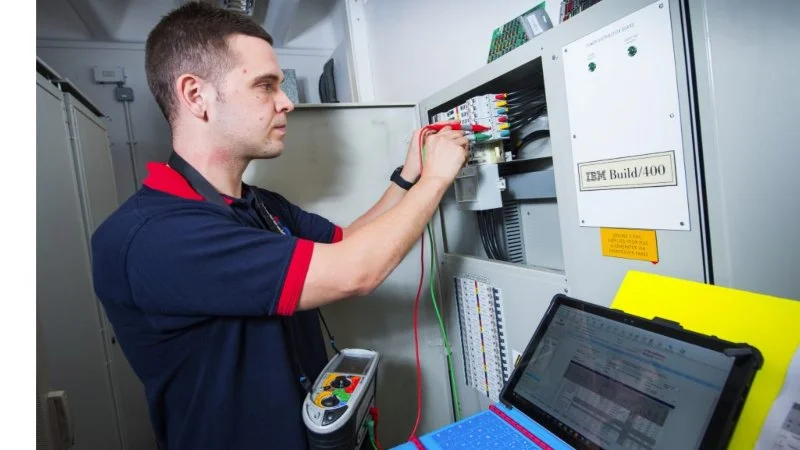Fixed wire testing, also known as periodic inspection and testing, is a critical aspect of electrical safety in the UK. It involves the inspection, testing, and certification of electrical systems in commercial, industrial, and residential properties. These regulations ensure that electrical installations are safe and meet the required standards for safety and efficiency. As an expert in electrical safety, I’ve compiled this comprehensive guide to help you understand the fixed wire testing regulations in the UK.
What is Fixed Wire Testing?
Fixed wire testing is the process of assessing the condition of an electrical installation. It involves testing the wiring, circuits, and equipment to ensure they are functioning safely. The tests include checking for potential hazards such as electrical faults, insulation breakdown, and wiring issues. The tests are typically carried out on circuits that are hard-wired, such as lighting, power circuits, and fire alarms.
Why is Fixed Wire Testing Important?
Electrical installations are subject to wear and tear over time, and they may not always function correctly or safely. Regular testing ensures that your electrical system complies with safety standards and prevents potential hazards like electric shocks, fires, or equipment failures. Fixed wire testing helps identify potential problems early, which could otherwise result in costly damage or serious injury.
Some of the main benefits of fixed wire testing include:
- Compliance with Legal Requirements: Ensures your property complies with regulations and standards set by law.
- Prevents Electrical Hazards: Identifies faults that could pose a fire or shock risk.
- Insurance Compliance: Many insurers require proof of periodic electrical testing to maintain coverage.
- Peace of Mind: Ensures that all electrical systems are in good working condition.
Fixed Wire Testing Regulations in the UK
In the UK, a number of regulations and standards govern fixed wire testing, including:
The Electricity at Work Regulations 1989
These regulations outline the responsibilities of employers and persons in control of electrical systems to ensure the safety of employees and anyone who may come into contact with the electrical installation. It is required by law that electrical installations are maintained and tested regularly to ensure they are safe to use.
The 18th Edition of the IET Wiring Regulations (BS 7671)
The IET Wiring Regulations, specifically the 18th Edition of BS 7671, set the standards for electrical installations in the UK. The regulations outline the requirements for the design, installation, and maintenance of electrical systems. Fixed wire testing falls under Part 6 of these regulations, which covers the requirements for inspections and testing.
According to BS 7671, all electrical installations must undergo periodic inspections and testing at regular intervals. The frequency of testing depends on the type of installation and its use. For example:
- Domestic properties: Every 10 years or when there is a change of occupancy.
- Commercial and industrial properties: Every 5 years, or more frequently if required by risk assessments.
- Special locations (e.g., swimming pools, healthcare facilities, and hazardous areas): More frequent testing may be required based on the specific risks.
The Health and Safety at Work Act 1974
This Act ensures the safety of employees and others on the premises. It places a legal duty on employers to maintain safe working environments, which includes ensuring that electrical systems are regularly tested and well-maintained.
Regulation 4 of the Electricity at Work Regulations
Regulation 4 of the Electricity at Work Regulations states that all electrical systems must be maintained in a safe condition. The regulation specifies that electrical installations must be tested to identify any faults and prevent potential hazards. Employers are responsible for ensuring these tests are carried out and that the systems are kept safe.
The Fixed Wire Testing Process
Qualified professionals, typically electrical contractors or electricians, carry out the fixed wire testing process. The process involves several key steps:
Visual Inspection
The first step in the testing process is a thorough visual inspection of the electrical installation. This includes checking:
- Condition of wiring and components
- Proper labelling of circuits
- Correct operation of all switches, sockets, and outlets
- The integrity of earthing and bonding systems
Testing the Installation
The actual testing includes several specific checks, such as:
- Insulation Resistance: Ensures there is no degradation in the insulation that could lead to a short circuit.
- Earth Continuity: Confirms that the earth path is intact and can safely carry fault current.
- RCD Testing: Ensures residual current devices (RCDs) are functioning properly to prevent electrical shocks.
- Earth Fault Loop Impedance: Checks the impedance of the earth fault loop to ensure the correct operation of protective devices.
- Polarity Check: Verifies that the wiring is correct and that there are no risks of electrical shock.
Issuing a Certificate
Once the tests are complete, a periodic inspection report (also known as an EICR – Electrical Installation Condition Report) is produced. This report outlines the results of the testing, identifies any issues, and provides recommendations for remedial work if required. The EICR will categorize any faults as:
- C1 (Danger present): Immediate danger, requiring urgent action.
- C2 (Potentially dangerous): Possible danger, requiring action soon.
- C3 (Improvement recommended): A recommendation for improvement, though not an immediate risk.
Frequency of Fixed Wire Testing
The frequency of testing depends on the type of property and its usage. Below is a general guide:
- Domestic Properties: Every 10 years or when the property changes occupancy.
- Commercial Buildings: Every 5 years or sooner if risk assessments indicate.
- Industrial Installations: Typically every 3 to 5 years, depending on usage.
- Schools, Hospitals, and other High-risk Areas: More frequent inspections may be required due to the higher risks associated with these environments.
What Happens if You Don’t Comply?
Failing to comply with fixed wire testing regulations can have serious consequences, including:
- Legal Penalties: Non-compliance with health and safety regulations can result in fines or imprisonment.
- Insurance Issues: If an incident occurs and you haven’t conducted regular testing, your insurance policy may not cover the damage or injury.
- Increased Risk: Without regular testing, electrical faults can go undetected, leading to potentially catastrophic consequences, such as fires or electric shocks.
Conclusion
An essential part of electrical safety in the UK is testing fixed wiring. Which ensures that electrical installations are maintained and comply with regulations. Regular testing helps identify potential hazards and ensures the safety of everyone who uses the electrical systems in a building. Adhering to the fixed wire testing regulations not only ensures compliance with the law but also safeguards lives and property. Ensure that qualified professionals carry out inspections and testing to achieve the highest level of safety.
By understanding the importance of fixed wire testing and following the regulatory guidelines, you can create a safer environment for both employees and residents, avoiding the risks of electrical faults and ensuring the longevity of your electrical installations.

